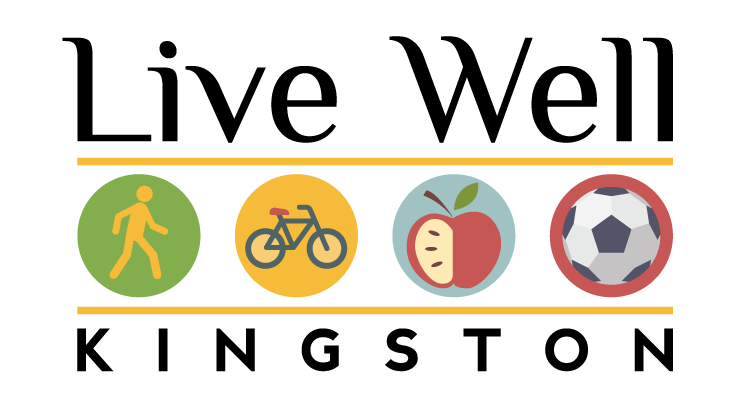Farmers Joel Zenie and Trish Hawkins wrote this beautiful post about their experience for their first year on the South Pine St. Farm in Midtown Kingston. Read on to learn the ins and outs of running an urban farm and to get some glorious insight into growing food on a precious piece of land in our little city.
To stay in touch with the farm visit: http://southpinestreetcityfarm.org/

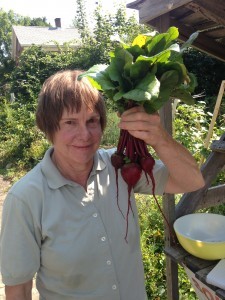 We’ve had a good first year at South Pine Street Farm. How lucky we are to have the opportunity to grow and sell vegetables right here in our home town! All thanks to the Kingston Land Trust (especially Kevin McEvoy, who worked out the details) and to Diane Davenport of Binnewater Ice who gives us the use of the land and water and asked only for a dollar and several bunches of mustard greens in return! We also give thanks to the three great farmers who came before us—Jesica, Kaycee and Phil—and to all those who first created Pine Street Farm. This first year was a great learning experience for Joel and Trish, an experience we treasure. We are providing fresh vegetables, teaching ourselves to be really excellent farmers, and connecting with the Kingston community at the farmstand. Our future goals include growing more, growing better, and finding new ways to sell and share the abundance we create.
We’ve had a good first year at South Pine Street Farm. How lucky we are to have the opportunity to grow and sell vegetables right here in our home town! All thanks to the Kingston Land Trust (especially Kevin McEvoy, who worked out the details) and to Diane Davenport of Binnewater Ice who gives us the use of the land and water and asked only for a dollar and several bunches of mustard greens in return! We also give thanks to the three great farmers who came before us—Jesica, Kaycee and Phil—and to all those who first created Pine Street Farm. This first year was a great learning experience for Joel and Trish, an experience we treasure. We are providing fresh vegetables, teaching ourselves to be really excellent farmers, and connecting with the Kingston community at the farmstand. Our future goals include growing more, growing better, and finding new ways to sell and share the abundance we create.
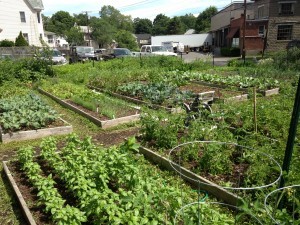 This year we grew vegetables in twenty 10 by 4 foot beds and sold our harvest at the gray wooden farmstand on Monday, Wednesday and Friday afternoons. Our first farmstand day was May 25 and our last was October 23. In early spring, Joel built the soil in the farm’s twenty beds with a combination of compost/mulch from Croswell Enterprises.
This year we grew vegetables in twenty 10 by 4 foot beds and sold our harvest at the gray wooden farmstand on Monday, Wednesday and Friday afternoons. Our first farmstand day was May 25 and our last was October 23. In early spring, Joel built the soil in the farm’s twenty beds with a combination of compost/mulch from Croswell Enterprises.
In the spring, Trish started picking up used organic coffee grounds from Uptown restaurants “Sissys” and the “Outdated Café.” The coffee mixed with leaves in the compost piles we are building at the back of the farm. We plan to be more and more independent when it comes to compost. We will be composting with shredded leaves and coffee grinds only. Food scraps will be composted in a “worm motel” at home, which will in turn yield worm castings for the soil at the farm.
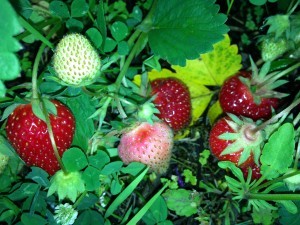 We had a good first year at the farm. We learned so much, met many wonderful customers, made a little money (and hope to make more in the future!), and enjoyed the whole farm experience. We planted lots of annual vegetables and also inherited some perennials like asparagus and strawberries from the farmers who came before us. We had a wonderful crop of June strawberries. They were a customer favorite and we also sold quite a few to Diane Reeder—one of the original founders of the farm—to make a strawberry lemonade she sold in her candy store on Wall Street. We are thinking about planting more June strawberries in the spring, as strawberries typically fade after about four years, and need to be replaced.
We had a good first year at the farm. We learned so much, met many wonderful customers, made a little money (and hope to make more in the future!), and enjoyed the whole farm experience. We planted lots of annual vegetables and also inherited some perennials like asparagus and strawberries from the farmers who came before us. We had a wonderful crop of June strawberries. They were a customer favorite and we also sold quite a few to Diane Reeder—one of the original founders of the farm—to make a strawberry lemonade she sold in her candy store on Wall Street. We are thinking about planting more June strawberries in the spring, as strawberries typically fade after about four years, and need to be replaced.
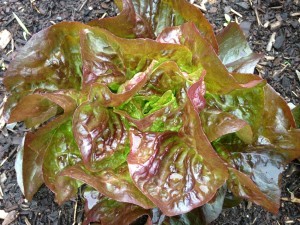 As for annual vegetables, Joel grew seedlings inside at home and transplanted them to the beds; and, of course, he also sowed seeds directly into the soil at the farm. Among many other crops, he planted a lettuce, called Alkindus, which is both red and green, with huge leaves that have a texture that is satisfying, lush. Lettuce is one of those vegetables where local is key—the texture of butterleaf does not transport well, so we see freshly harvested lettuce as one of key vegetables for next season.
As for annual vegetables, Joel grew seedlings inside at home and transplanted them to the beds; and, of course, he also sowed seeds directly into the soil at the farm. Among many other crops, he planted a lettuce, called Alkindus, which is both red and green, with huge leaves that have a texture that is satisfying, lush. Lettuce is one of those vegetables where local is key—the texture of butterleaf does not transport well, so we see freshly harvested lettuce as one of key vegetables for next season.
One of Joel’s favorite books is “The Good Life” by Scott and Helen Nearing. The Nearings were in their forties when they started their self-sufficient way of farming and life in Vermont, and they lived to ripe old ages. The Nearings grew lettuce and greens in very cold conditions. Next year we plan to extend our growing season as late as we can. We want to get hoops that we can bend to fit the beds to support row cover and even plastic sheeting, with clips that are easy to unfasten and fasten again.
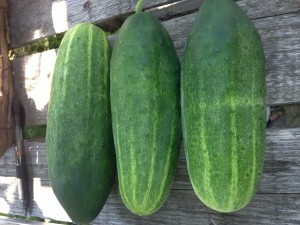 We grew two half beds of cucumbers—a favorite of two kids with their Dad who bought cukes every time they passed by. Our vines provided a great many good cucumbers but we also ran into trouble with yellow color in some and the plants themselves died back earlier than we expected. We plan to run a special test on the soil in the beds we plant cukes in next season, so we can add appropriate nutrients and improve our harvest. We are sending soil samples from other beds to Rutgers soil lab and an additional sample to Logan bionutrient soil lab in Ohio.
We grew two half beds of cucumbers—a favorite of two kids with their Dad who bought cukes every time they passed by. Our vines provided a great many good cucumbers but we also ran into trouble with yellow color in some and the plants themselves died back earlier than we expected. We plan to run a special test on the soil in the beds we plant cukes in next season, so we can add appropriate nutrients and improve our harvest. We are sending soil samples from other beds to Rutgers soil lab and an additional sample to Logan bionutrient soil lab in Ohio.
We grew a half bed—that’s a ten by four foot plot—of basil. The basil was very productive and we want to grow even more next year so we have plenty to sell at the farmstand and to restaurants in the area (as well as making lots of pesto!) We also plan to grow parsley next year, and more dill and more cilantro.
 Kale and collards were our mainstay. In November, they’re still growing at the farm. We also grew some chard. Next season we plan to grow even more varieties of kale, which was very popular at the stand, and also more chard. We also want to grow more beets next year, more onions.
Kale and collards were our mainstay. In November, they’re still growing at the farm. We also grew some chard. Next season we plan to grow even more varieties of kale, which was very popular at the stand, and also more chard. We also want to grow more beets next year, more onions.
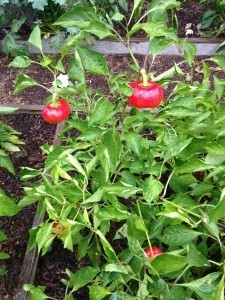 Another good thing we did this year was plant red pimento peppers—they are small and shaped like mini pumpkins and their flesh is thick and sweet—more of these will be grown next year!
Another good thing we did this year was plant red pimento peppers—they are small and shaped like mini pumpkins and their flesh is thick and sweet—more of these will be grown next year!
The asparagus we inherited is on a side strip at the farm and had gotten very weedy. We are weeding it thoroughly now, laying down newspapers and leaves so that next year the weeds will have calmed down a bit and we can perhaps plant some more asparagus or maybe mix in parsley or rhubarb.
One problem that we were warned about never reached crisis level. The woodchucks did not visit us much, though they live right across the street. This may have been because we unmasked their holes near the raspberries and filled them with rocks. Or because we had strategically placed vials of coyote pee near the holes and tied along the fence. The only real damage we suffered was that some animals—perhaps woodchucks—nibbled a bed of young kale. We covered the bed after that and the kale is at this late date reaching a nice maturity. We also had the thrill of seeing a young raccoon who couldn’t seem to figure out how to get out of the garden. We reopened a hole in the fence and he was gone the next day.
As for water, we run a hose from the Binnewater spigot across the street. It works. Next year we would like to experiment with drip irrigation on a few beds. As you may know, watering from below is better for tomatoes and other crops than spraying water from above. Kaycee Wimbish has told us where she went to get an irrigation system for the Y, and we will see if we can experiment with drip irrigation on a couple of beds next year.
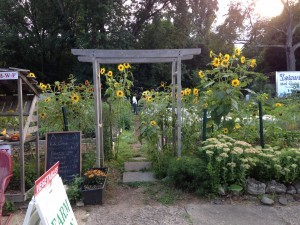 Joel and Trish love arriving at the wood gate of the farm, which looks a little Japanese, and seeing the birds rising from the beds and flying off. We want to look after and further beautify the property, including the back of the lot where there are picnic tables and a rather neglected lawn and shade garden. Perhaps we can find a gardener or landscape enthusiast who would like to look after that spot. We want our beneficial flowering weeds to remain, but we are working to minimize the vines, including a bit of poison ivy. We’d like the back area to be a spot where people can feel free to come and sit and perhaps even have a salad. Not a beer garden, a salad garden!
Joel and Trish love arriving at the wood gate of the farm, which looks a little Japanese, and seeing the birds rising from the beds and flying off. We want to look after and further beautify the property, including the back of the lot where there are picnic tables and a rather neglected lawn and shade garden. Perhaps we can find a gardener or landscape enthusiast who would like to look after that spot. We want our beneficial flowering weeds to remain, but we are working to minimize the vines, including a bit of poison ivy. We’d like the back area to be a spot where people can feel free to come and sit and perhaps even have a salad. Not a beer garden, a salad garden!
We hope to acquire an old washing machine that we can run without water on the spin cycle to dry our lettuce and mesclun. We also wish for a small refrigerator to store our produce overnight.
 We are included in the “Eat Well Focus Team” of the Live Well Kingston Coalition and have been going to their meetings and gathering new ideas about where and how to sell our produce next year. Kaycee Wimbish at the Y has been very helpful to us throughout the season. We want to do more walking of the streets in different Kingston neighborhoods with our cards and perhaps even with our produce, as well as connecting to restaurants and small institutional kitchens. A major goal is to produce and sell enough food to have a surplus to donate to soup kitchens and individuals who cannot afford to buy produce. We are very open to ideas and suggestions—both about growing and about marketing. We are learning, and outside eyes can be helpful, so don’t hesitate to visit the farm and share your impressions or bright ideas.
We are included in the “Eat Well Focus Team” of the Live Well Kingston Coalition and have been going to their meetings and gathering new ideas about where and how to sell our produce next year. Kaycee Wimbish at the Y has been very helpful to us throughout the season. We want to do more walking of the streets in different Kingston neighborhoods with our cards and perhaps even with our produce, as well as connecting to restaurants and small institutional kitchens. A major goal is to produce and sell enough food to have a surplus to donate to soup kitchens and individuals who cannot afford to buy produce. We are very open to ideas and suggestions—both about growing and about marketing. We are learning, and outside eyes can be helpful, so don’t hesitate to visit the farm and share your impressions or bright ideas.
Thank you, Kingston Land Trust!
